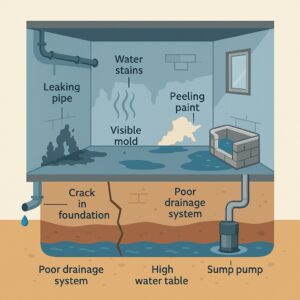
Water leaks in the basement can cause significant damage to your home, leading to costly repairs, mold growth, and even structural problems if not dealt with promptly. Identifying and preventing water leaks in the basement is critical for maintaining the integrity of your home. This article will guide you on how to identify water leaks in your basement and provide practical steps on how to stop a water leak, ensuring you protect your property and avoid costly damage.
Identifying Water Leaks in the Basement
The first step in preventing basement water leaks is identifying them early. Water damage can be hidden and hard to spot, so it’s important to regularly check for signs that may indicate a problem. The following are common indicators of water leaks in basements:
Damp or Musty Odors
A musty smell is one of the most noticeable signs of water infiltration. If you notice a damp, earthy odor in your basement, it could be a sign that moisture is present. The odor is often caused by mold or mildew growth, which thrives in wet environments. Pay close attention to areas with poor ventilation, as these are more likely to harbor moisture.
Water Stains or Discoloration
Water stains on basement walls, floors, or ceilings are another clear sign that there is water leaking. These stains may appear as dark patches or streaks and are often caused by moisture seeping through the walls or floor. If the stains are recent, they may appear as wet or damp spots. In contrast, older water stains will be dry but may have left behind visible discoloration or mineral deposits.
Peeling Paint or Wallpaper
Water leaks can cause paint and wallpaper to peel or bubble up. The presence of water behind the walls can cause the surface to become loose and deteriorate over time. If you notice that the paint or wallpaper in your basement is bubbling or peeling, it’s a good idea to investigate further to identify the source of the water.
Visible Mold or Mildew Growth
Mold and mildew thrive in damp environments, so their appearance in the basement is a strong indication of water leaks. Mold often grows in hidden areas such as behind walls or under floors, making it difficult to spot. However, if you see visible patches of mold on surfaces, it’s important to address the moisture issue quickly to prevent further damage and potential health risks.
Pools of Water
The most obvious sign of a water leak is the presence of standing water in the basement. Pools of water on the floor, especially after a rainstorm or snowmelt, suggest that water is entering your basement through cracks, window wells, or other entry points. Standing water can quickly cause damage to your floors, furniture, and other belongings, so it’s essential to deal with it as soon as possible.
Common Causes of Basement Water Leaks
Understanding the causes of water leaks in your basement will help you prevent them in the future. Below are some of the most common reasons water infiltrates basements:
Poor Drainage Systems
One of the primary causes of basement water leaks is poor drainage around the foundation of your home. When the ground around your foundation does not slope away from the house, water can pool around the walls and seep through cracks in the foundation. This is particularly common during heavy rain or snowmelt. Installing proper drainage systems, such as gutters and downspouts, can help divert water away from your home and reduce the risk of basement leaks.
Cracks in the Foundation
Over time, the foundation of your home can develop cracks due to settling, shifting, or natural wear and tear. These cracks provide a direct entry point for water to seep into your basement. Cracks may also occur around windows or doors. Foundation cracks can range in size from tiny hairline fissures to large gaps that let in a significant amount of water.
Leaking Pipes
Another common cause of water leaks in basements is leaking plumbing pipes. If you have old or damaged pipes in your basement, they may begin to leak over time, especially during the winter months when freezing temperatures can cause pipes to crack. Leaking pipes can damage your flooring and other materials, so it’s essential to repair them promptly. Knowing how to stop a water leak from a pipe involves turning off the water supply and fixing the damaged section of the pipe before it causes more damage.
Window Wells
If your basement has windows below ground level, they may have window wells to allow light into the space. However, these window wells can accumulate water if they are not properly drained. Water can overflow into the basement if the well becomes too full, leading to leaks. Installing proper drainage around the window wells and ensuring they are free of debris can help prevent water from entering your basement.
High Water Table
In areas where the water table is high, water can naturally seep into the basement through the foundation. This is particularly problematic in areas that experience heavy rainfall or snowmelt, as the water table rises and puts pressure on the foundation, forcing water inside. Waterproofing solutions and sump pumps can help alleviate this issue.
How to Stop a Water Leak in the Basement
Now that you know how to identify water leaks and the common causes, it’s time to take action and how to stop a water leak. There are several ways to address water leaks in your basement, ranging from simple DIY fixes to more complex solutions. The following steps will help you take control of the situation:
Inspect the Foundation
Start by inspecting the foundation for visible cracks or gaps. Use a flashlight to check the exterior and interior walls for signs of damage. Small cracks can be sealed with hydraulic cement or epoxy, which can effectively stop water from entering the basement. For larger cracks, it’s advisable to consult a professional to assess the situation and make more extensive repairs.
Check and Repair Pipes
Leaking pipes in the basement can lead to significant water damage, so it’s essential to inspect them regularly. If you notice any signs of leaks, such as damp spots on walls or ceilings, it’s important to repair the pipes immediately. Replacing old or damaged pipes and ensuring proper insulation can help prevent future leaks, particularly in cold weather.
Improve Drainage Around Your Home
Ensuring proper drainage around your home is one of the most effective ways to prevent basement water leaks. Make sure your gutters and downspouts are clean and functioning properly. If you notice that the water is pooling near your foundation, consider installing a French drain or other drainage systems to divert water away from the home.
Install a Sump Pump
A sump pump is a powerful tool that can help remove water from your basement if it enters. Sump pumps are typically installed in a pit in the lowest part of the basement and automatically activate when water levels rise. If you live in an area with a high water table or frequent flooding, installing a sump pump can be a crucial step in preventing water damage.
Waterproof the Basement
If you live in an area prone to water issues, waterproofing your basement can provide long-term protection. Waterproofing involves applying a sealant to the exterior of your foundation and basement walls to prevent water from seeping through. While it can be an expensive solution, waterproofing is effective in stopping water infiltration and can help prevent mold growth and structural damage.
Install Window Well Covers
If your basement has window wells, consider installing window well covers. These covers help prevent water from accumulating in the well and overflowing into the basement. They also protect the windows from debris, which can clog the drainage system. Be sure to choose covers that are strong and durable enough to withstand heavy rain or snow.
Preventing Future Water Leaks
Once you’ve addressed any current water leaks in your basement, it’s important to take steps to prevent future issues. Regular maintenance and monitoring can help you spot potential problems before they become major issues. Here are a few tips for ongoing prevention:
- Regularly Inspect Your Basement: Perform periodic checks to ensure that there are no new signs of water damage or leaks. This will allow you to address any potential issues early on.
- Keep Gutters and Downspouts Clean: Regularly clean your gutters and downspouts to prevent blockages that could cause water to overflow and pool around the foundation.
- Ensure Proper Landscaping: Make sure the ground around your foundation slopes away from your home to prevent water from collecting near the basement walls.
- Maintain Your Sump Pump: Test your sump pump regularly to ensure it’s working properly. If it malfunctions, it could lead to water flooding your basement during a heavy rainstorm.
By staying vigilant and proactive, you can prevent water leaks in your basement and protect your home from long-term damage. Identifying the signs early and taking steps on how to stop a water leak will help you avoid costly repairs and ensure a safe, dry basement for years to come.





